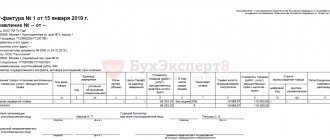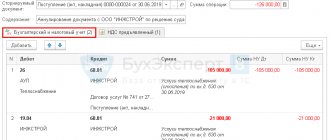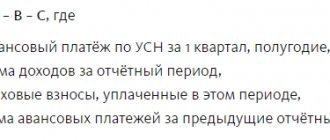How it works
Previously, a more complex algorithm was in effect.
For example, NPO Dobrovol sold goods, works, and services to a third-party company. The documentation confirming the fact of sale, in this case, is a delivery note, which is signed by both parties when transferring finished products, goods and other inventory items, or a certificate of services performed, which is also signed by the customer and the contractor upon completion of the work or services. Only after signing the invoice or act did the contractor issue an invoice for payment.
What happens now? The reduced document flow between companies looks like this. For example, when shipping goods, the contractor issues a universal transfer document instead of a delivery note and an invoice. In the PD form, both documents are combined. Consequently, the customer, having received the goods, can immediately proceed to payment. A similar option applies to the sale of works and services.
The current universal PD form is approved by a separate Letter of the Federal Tax Service dated October 21, 2013 No. ММВ-20-3/ [email protected] in accordance with the Decree of the Government of the Russian Federation dated December 26, 2011 No. 1137 and Law No. 402-FZ “On Accounting”.
Rules for registration of UPD
Appendices No. 2-4 to the Federal Tax Service letter No. ММВ-20-3/96 provide instructions for filling out the UPD, including a list of transactions for which this form can be used. The design features of the UPD vary depending on the status of the document:
- Status “1” means that the UPD combines an invoice and a transfer act, which means that all lines required for these documents are filled in (the fields of the invoice are drawn up taking into account the rules for filling them out, approved by Government Decree No. 1137 dated December 26, 2011 latest edition). Our example of filling out the UPD is given for status “1”.
- Status “2” – UPD includes only the transfer deed and is used as a primary document. In this case, the fields required for the invoice are not filled in: line 5, columns 6, 7, 10, 10a, 11; the remaining fields must be filled in. Incorrect indication of status “2” instead of “1” does not deprive the buyer of the right to a VAT deduction if the rules for filling out all indicators related to the invoice in the UPD are followed. Status “2” is applicable for “simplified” people and those who are not VAT payers, since issuing a UTD does not entail for them the obligation to pay this tax.
Correct execution of the UTD (a sample of which we provide) assumes that a document with status “1” is assigned a number according to the chronology of invoice numbering.
UTD with status “2” are numbered in the order corresponding to the numbering of the “primary”: acts, invoices, etc.
Universal PD form
IMPORTANT!
This form is just a recommendation from officials. The company has the right to use other UPD, the forms of which are developed and approved in the company’s accounting policies. However, when creating an individual form of transfer documentation, take into account the mandatory details for primary documents (Article 9 of Law No. 402-FZ).
Documents replaced by the new form
Previously, the transfer documents required for registration were the consignment note, the commodity part of the consignment note and the transfer act in approved forms. Now all these forms have lost their relevance and necessity, although they can still be used by organizations if desired. Each company must set out information about which documents to use in its work in its accounting policies on an individual basis.
Who can use it and when?
The form of universal primary documentation can be used by almost all organizations and individual entrepreneurs, including public sector institutions and non-profit organizations. Moreover, the chosen taxation system does not play any role.
A universal PD can be used to reflect the following operations:
- When selling goods (finished products, inventory items, inventories), performing work or providing services.
- When transferring property rights to assets.
- When completing transactions for intermediary operations.
Certain types of transactions and operations are named in the second section of the Federal Tax Service letter dated October 21, 2013 No. ММВ-20-3/ [email protected]
Can an individual entrepreneur issue UPD on the simplified tax system?
As we have already said, entrepreneurs can submit UTD in different tax systems. The only difference is that special regime officers put the sign “2” in the document, meaning exemption from VAT. On the general taxation system, sign “1” is written in the left corner.
Thus, for an individual entrepreneur using the simplified tax system, the universal acceptance document will serve as a primary document containing information about the shipment of goods/services, without allocating VAT.
If errors are found in the completed form - the name of the product, unit of measurement, quantity are indicated incorrectly - the data is crossed out and the correct values are written on top. All adjustments made are certified by the signature of the official.
The UPD is registered in chronological order, according to the principle of any primary. To make it more informative, the form can be changed by adding new lines and columns. If you decide to use this document, do not forget to include it in the list of your document flow.
We recommend reading: Invoice from the supplier for individual entrepreneurs according to the simplified tax system.
Rules and sample for filling out the UPD
For the UPD, the filling rules are approved in the second appendix of the Letter of the Federal Tax Service dated October 21, 2013 No. ММВ-20-3/ [email protected] Let's consider the basic rules:
| Line, indicator | Explanation |
| Status | We indicate “1” if the UPD is drawn up as an invoice and a statement or invoice. If the UPD is formed exclusively as an act of completed work, a delivery note, indicate “2”. |
| Lines 2 to 7 | We fill in the registration information about the contractor and the customer. We write down the name, tax identification number, checkpoint, address. We add information about the shipper, if necessary. Then we enter the unit of measurement (usually 643 - Russian ruble). |
| Tabular part | We write down information about the product, work, service for which the transfer document is drawn up. |
| Signatures of responsible persons | The document must be certified by the manager and chief accountant or other responsible persons by proxy. |
| A document base | Indicate the supply contract or agreement for the provision of work or services, or another document basis on which the transaction is carried out. |
| Signatures of the contractor and the customer | The position and full name are indicated. the person responsible for the transfer and acceptance of goods, works, services. Then the responsible persons sign and seal them with the seals of the organization (if any). |
How to sign IP UPD
Often the individual entrepreneur is faced with the question of how to properly sign the UPD. Both parties to the transaction - the seller and the buyer, or their authorized representatives - are required to certify the document with signatures. We show where to sign the UPD in the table:
| Field in UPD: where to put signatures | Who signs | What does the signature confirm? | Notes |
| In the subsection with the invoice | Individual entrepreneur - the seller (or his representative) signs the UPD and indicates the details of the state registration certificate | The fact of the transaction and its documentation | |
| In field 10 | Salesman | Fact of shipment | |
| In field 13 | Salesman | Reliability of data in UPD |
|
| In field 15 | Buyer | Receiving goods/services | |
| In field 18 | Buyer | Correctness of the document |
|
For greater clarity, we offer an example of the formation of UTD without VAT. Sample form for 2021:
Signing
Officially, the UPD template has 5 columns for signing the document by the seller. But not all fields must be signed.
- If it is used only in the status of primary documentation, then two signatures are sufficient: from the head of the organization and the chief accountant.
- If the UPD is used as a replacement for TORG-12 and an invoice, then there will also be the signatures of the person who shipped the goods, the signature of the person responsible for registering the fact of economic life on the part of the seller.
There will also be signatures from the buyer: the person who received the goods and is responsible for the economic part.
Notifications on the regulatory legal acts portal
- VAT codes, ID 02/08/06-17/00067207
- VAT return, ID 02/08/06-17/00067201
Give your rating to this article: ( 4 ratings, average: 4.00 out of 5)
Registered users have access to more than 300 video lessons on working in 1C: Accounting 8, 1C: ZUP
Registered users have access to more than 300 video lessons on working in 1C: Accounting 8, 1C: ZUP
I am already registered
After registering, you will receive a link to the specified address to watch more than 300 video lessons on working in 1C: Accounting 8, 1C: ZUP 8 (free)
By submitting this form, you agree to the Privacy Policy and consent to the processing of personal data
Login to your account
Forgot your password?
In what cases is the document used?
The main reasons for issuing a universal transfer document are the following cases:
- shipment of goods, materials, equipment for various purposes,
- intermediary operations,
- transfer and acceptance of work performed and services provided,
- transfer of certain types of property rights.
If the form is completed in full and correctly, the document is proof that the transaction was completed legally and is accepted as the primary accounting document justifying the accounting entries for the receipt of works, services, goods and materials. The document also serves as the basis for deducting VAT.
Rules for drawing up a universal transfer document
Despite the fact that this form is enshrined in law, its use is not mandatory. In some cases, as mentioned above, it can be replaced by other documents or adjusted depending on the needs of the organization. However, it should be noted that the document must contain some mandatory details:
- his name,
- Date of preparation,
- the name of the company whose employees are registering it,
- the meaning of the operation it accompanies,
- cost of inventory items or services,
- their number,
- information about responsible persons (indicating positions, surnames, first names, patronymics),
- signatures with transcripts.
If the document is subject to changes and editing within the enterprise, the above information cannot be excluded from the form, otherwise, the universal transfer document will not be considered a legal basis for accounting entries, receipt of transactions and inventory items, and VAT refund.
What changes from July 1, 2021
From July 1, 2021, a new invoice form must be used. The updated form has been supplemented with a new line in which sellers write down the identifier of the government contract (Resolution of the Government of the Russian Federation dated May 25, 2017 No. 625). Moreover, it is now possible to exchange electronic invoices only in the format approved by Order No. ММВ-7-15/155 dated March 24, 2016. We reported on this in detail in the article “Invoice from July 1, 2021: form and format.”
From July 1, 2021, tax inspectors will not accept invoices using the old form and format. Accept only new documents from counterparties so as not to lose VAT deductions. Also see “VAT from July 1, 2021: what has changed.”
Organizations that work with electronic invoices can combine all shipping documents into one universal transfer document (UTD). This is convenient - you can not only exchange electronic UPDs with partners, but also transfer them to the Federal Tax Service. However, given that the invoice form has been updated since July 1, the form of the universal transfer document also needs to be adjusted.
If the UPD is used simultaneously as an invoice and a primary document, then the form of the invoice in the UPD should not change.
Despite the approval of the new invoice form (new column 8), no changes have been approved regarding the UPD form since July 1, 2021. The Federal Tax Service, apparently, has not yet had time to develop a new form of the UPD form. Therefore, for our readers, we have prepared a form for a new universal transfer document, which we have supplemented with the necessary details about the government contract identifier. It (identifier) must be indicated to organizations that sell goods or perform work under government orders and provided that such a number is assigned.
new UPD form for use from July 1, 2021.
From July 1, 2021, issue electronic invoices only according to the format from Order No. ММВ-7-15/155. It allows you to issue a separate invoice or a universal transfer document.
Instructions for preparing a universal transfer document
Articles on the topic
Any business transactions at the enterprise, for example, shipment of goods, ordering services, must be formalized using primary documentation. In order to reduce the number of papers and simplify the document flow procedure, the UTD was introduced in 2013 - a universal transfer document.
A universal transfer document is a form that contains the necessary details and can replace an invoice, a certificate of completion of work, invoices and other primary documentation.
Rules for filling out the UPD, which replaces only the invoice (or act)
In the universal transfer document with status 2, you can omit filling in fields that are mandatory exclusively for the invoice. It is permissible to either leave such rows and columns empty or put a dash in them.
This applies to line (7) “To the payment and settlement document”, to columns 6 and 7, intended for the amount of excise duty and tax rate, and to columns 10, 10a and 11, intended for information about the country of origin of the imported goods and the customs declaration.
It is possible that UTD with status 2 will be companies or entrepreneurs that are not VAT payers. In this case, column 7 “Tax rate” and column 8 “Tax amount presented to the buyer” do not need to be filled out.
Then, despite the name “invoice”, the universal document will not entail the obligation to calculate and pay VAT.
Also, UPD with status 2 can be filled out by consignors, principals and principals who transfer their goods to commission agents, agents or attorneys for sale to third-party clients. Such a universal document will act as a “primary document” confirming the transfer of values without transfer of ownership of them.
In this case, in line (8) “Base for transfer (delivery) / receipt (acceptance)” you must indicate the agreement for the provision of intermediary services. And lines (2), (2a), (2b), (6), (6a) and (6b), intended for information about the seller and buyer, do not need to be filled out.
Recommendations for filling out other UPD details are given in Table 1.
Recommendations for filling out some UPD details
UPD and SSF
Invoice is an NU document. It confirms the release of goods to the buyer, the provision of services to him, the performance of work on operations subject to VAT, and is not used anywhere else. SChF details contain information:
- about the subject of the transaction;
- about his country of origin;
- about the amount;
- on the quantitative characteristics of a business transaction;
- about the tax rate;
- about excise tax;
- about the relevant group of goods;
- allowing taxpayers to be identified.
The information contained in the SSF is used for VAT calculations and control of these transactions. When registering the release of goods, an accounting document is attached to the SChF: delivery note, delivery and acceptance certificate, etc.
The Universal Transfer Document (UDD) is a form created on the basis of the SSF. All information from the SSF is reflected in the UPD.
For convenience, the “invoice area” is highlighted with a dark outline. In addition, the UPD contains information on the issue of goods and materials (act, bill of lading, partially - TTN, document on issue of materials f.
M-11, etc.), i.e. information when the shipment was made, which official took responsibility for it and signed it, and on the basis of which agreement the shipment was made.
UPD can be used both in BU and NU. The nature of use is marked with a number (1 or 2) - on the left side of the form, at the top:
- With status 1, the UPD acts as both an invoice and a document confirming the transfer.
- With status 2, the UPD is filled out only as a BU document.
It is obvious that SSF can be replaced by UPD with a simultaneous reduction in document flow. However, complete replacement in accounting practice does not occur. There are objective reasons for this.
What is better – invoice or UTD?
Using universal transfer documents in an organization has a number of advantages:
- simplification of document flow;
- reduction of the archive of accounting papers;
- preparation of documents in a uniform style;
- reduction of errors in document preparation;
- saving time on preparing documents, reducing paper costs.
The UPD is very convenient to use, since when registering various transactions it is filled out according to a single template. Responsible persons will not have to think about how to fill out the invoice in the TORG-12 or M-15 form. A sample of filling out the UPD for services can be taken as a basis.
It can be concluded that the use of UTD is more profitable compared to the use of conventional invoices. The need for UPD has been brewing for a long time, and it is the future. But sometimes situations still arise when it is impossible to do without issuing invoices.
Results
The universal transfer document was developed to facilitate the execution of transactions for the sale of goods, works and services: one document instead of two.
UTD is the basis for the calculation or deduction of VAT, to confirm income for the seller or expenses for the buyer. The tax authorities check the UPD according to the same criteria as the check of the usual primary documents and invoices. There are no tax risks when using the UTD provided that it is filled out correctly. You can find more complete information on the topic in ConsultantPlus. Free trial access to the system for 2 days.







